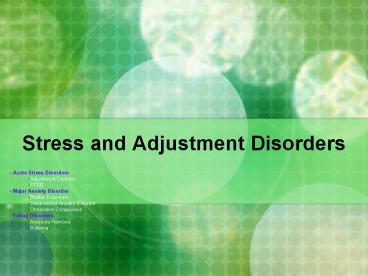Stress and Adjustment Disorders - PowerPoint PPT Presentation
1 / 7
Title:
Stress and Adjustment Disorders
Description:
At the heart of both disorders is. An intense and pathological fear of ... Perfectionism. Childhood sexual abuse may play a role. Eating Disorders. Treatment: ... – PowerPoint PPT presentation
Number of Views:266
Avg rating:3.0/5.0
Title: Stress and Adjustment Disorders
1
Stress and Adjustment Disorders
- Acute Stress Disorders
- Adjustment Disorder
- PTSD
- Major Anxiety Disorder
- Phobic Disorders
- Generalized Anxiety Disorder
- Obsessive-Compulsive
- Eating Disorders
- Anorexia Nervosa
- Bulemia
2
Eating Disorders
- Two most common forms of eating disorders are
- Anorexia nervosa
- Bulimia nervosa
- At the heart of both disorders is
- An intense and pathological fear of becoming
overweight and fat - A pursuit of thinness that is relentless and
sometimes deadly
3
Eating DisordersAnorexia Nervosa
- Defined
- A fear of gaining weight
- A refusal to maintain a normal weight
- Two types of anorexia nervosa
- Restricting type
- Binge-eating/purging type
- Mortality rate for females with anorexia nervosa
is more than twelve times higher than the
mortality rate for females aged 1524 in the
general population. - Anorexia can lead to
- Death from heart arrhythmias
- Kidney damage
- Renal failure
4
Eating DisordersBulimia Nervosa
- Defined
- Frequent episodes of binge eating
- Lack of control over eating
- Recurrent inappropriate behavior to prevent
weight gain - Typically normal weight.
- Bulimia can lead to
- Electrolyte imbalances
- Hypokalemia (low potassium)
- Damage to hands, throat, and teeth from induced
vomiting - Binge-eating Disorder
- Similar to bulimia without any form of
compensatory behavior.
5
Eating Disorders
- Anorexia nervosa is most likely to develop in 15-
to 19-year-olds - Bulimia nervosa is most likely to develop in
women aged 20-24 - There are 10 females for every male with an
eating disorder - Associated with the following disorders
- Clinical depression
- Obsessive-compulsive disorder
- Substance abuse disorders
- Various personality disorders
- Prevalence
- The lifetime prevalence of anorexia nervosa is
around 0.5 - The lifetime prevalence of bulimia is around 13
6
Eating Disorders
- Causal Factors
- Sociocultural influences such as fashion
magazines idealize extreme thinness - Women often internalize the thin ideal
- Families of anorexics are described as showing
the following characteristics - Limited tolerance of disharmonious affect or
psychological tension - An emphasis on propriety and rule-mindedness
- Parental overdirection of the child or subtle
discouragement of autonomous strivings - Poor skills in conflict resolution
- Preoccupations regarding the desirability of
thinness, dieting, and good physical appearance - Nearly all instances of eating disorders begin
with normal dieting - Other risks factors include
- Negative affect
- Perfectionism
- Childhood sexual abuse may play a role
7
Eating Disorders
- Treatment
- Emergency procedures to restore weight
- Cognitive-behavioral therapy
- Antidepressants or other medications
- Family therapy
- Bulimia Specific
- Antidepressants or other medications
- Cognitive-behavioral therapy































